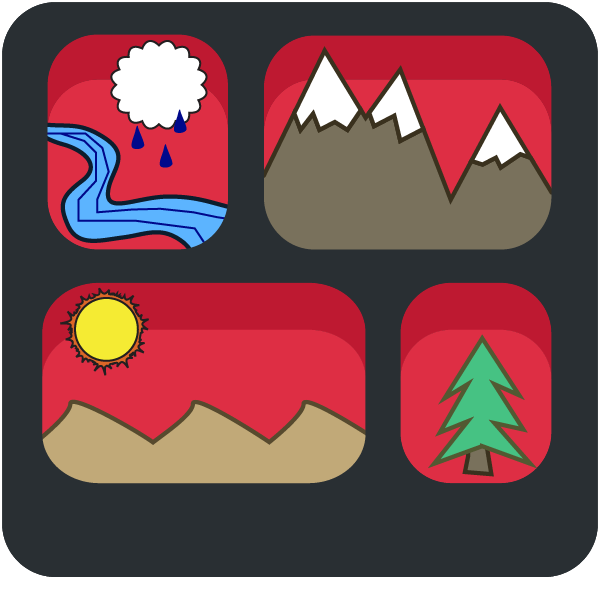-
class
BasicDdSt¶
Model BasicDdSt¶
terrainbento BasicDdSt model program.
Erosion model program using linear diffusion, smoothly thresholded stream power, and stochastic discharge with a smoothed infiltration capacity threshold. The program differs from BasicStTh in that the threshold value depends on cumulative incision depth, and so can vary in space and time.
- Landlab components used:
DepressionFinderAndRouter (optional)
StreamPowerSmoothThresholdEroder
-
class
BasicDdSt(clock, grid, m_sp=0.5, n_sp=1.0, water_erodibility=0.0001, regolith_transport_parameter=0.1, water_erosion_rule__threshold=0.01, water_erosion_rule__thresh_depth_derivative=0.0, infiltration_capacity=1.0, **kwargs)[source]¶ Bases:
terrainbento.base_class.stochastic_erosion_model.StochasticErosionModelBasicDdSt model program.
This model program uses a stochastic treatment of runoff and discharge, and includes an erosion threshold in the water erosion law. The threshold depends on cumulative incision depth, and therefore can vary in space and time. It combines models
BasicDdandBasicSt.The model evolves a topographic surface, \(\eta (x,y,t)\), with the following governing equation:
\[\frac{\partial \eta}{\partial t} = -\left[K_{q}\hat{Q}^{m}S^{n} - \omega_{ct} \left(1-e^{-K_{q}\hat{Q}^{m}S^{n} / \omega_{ct}}\right)\right)] + D \nabla^2 \eta\]where \(\hat{Q}\) is the local stream discharge (the hat symbol indicates that it is a random-in-time variable) and \(S\) is the local slope gradient. \(m\) and \(n\) are the discharge and slope exponent, respectively, \(\omega_c\) is the critical stream power required for erosion to occur, \(K\) is the erodibility by water, and \(D\) is the regolith transport parameter.
\(\omega_{ct}\) may change through time as it increases with cumulative incision depth:
\[\omega_{ct}\left(x,y,t\right) = \mathrm{max}\left(\omega_c + b D_I\left(x, y, t\right), \omega_c \right)\]where \(\omega_c\) is the threshold when no incision has taken place, \(b\) is the rate at which the threshold increases with incision depth, and \(D_I\) is the cumulative incision depth at location \(\left(x,y\right)\) and time \(t\).
Refer to Barnhart et al. (2019) Table 5 for full list of parameter symbols, names, and dimensions.
- The following at-node fields must be specified in the grid:
topographic__elevation
-
__init__(clock, grid, m_sp=0.5, n_sp=1.0, water_erodibility=0.0001, regolith_transport_parameter=0.1, water_erosion_rule__threshold=0.01, water_erosion_rule__thresh_depth_derivative=0.0, infiltration_capacity=1.0, **kwargs)[source]¶ - Parameters
clock (terrainbento Clock instance) –
grid (landlab model grid instance) – The grid must have all required fields.
m_sp (float, optional) – Drainage area exponent (\(m\)). Default is 0.5.
n_sp (float, optional) – Slope exponent (\(n\)). Default is 1.0.
water_erodibility (float, optional) – Water erodibility (\(K\)). Default is 0.0001.
regolith_transport_parameter (float, optional) – Regolith transport efficiency (\(D\)). Default is 0.1.
water_erosion_rule__threshold (float, optional) – Erosion rule threshold when no erosion has occured (\(\omega_c\)). Default is 0.01.
water_erosion_rule__thresh_depth_derivative (float, optional) – Rate of increase of water erosion threshold as increased incision occurs (\(b\)). Default is 0.0.
infiltration_capacity (float, optional) – Infiltration capacity (\(I_m\)). Default is 1.0.
**kwargs – Keyword arguments to pass to
StochasticErosionModel. These arguments control the discharge \(\hat{Q}\).
- Returns
BasicDdSt
- Return type
model object
Examples
This is a minimal example to demonstrate how to construct an instance of model BasicDdSt. For more detailed examples, including steady-state test examples, see the terrainbento tutorials.
To begin, import the model class.
>>> from landlab import RasterModelGrid >>> from landlab.values import random >>> from terrainbento import Clock, BasicDdSt >>> clock = Clock(start=0, stop=100, step=1) >>> grid = RasterModelGrid((5,5)) >>> _ = random(grid, "topographic__elevation")
Construct the model.
>>> model = BasicDdSt(clock, grid)
Running the model with
model.run()would create output, so here we will just run it one step.>>> model.run_one_step(1.) >>> model.model_time 1.0
-
run_one_step(step)[source]¶ Advance model BasicDdSt for one time-step of duration step.
The run_one_step method does the following:
Creates rain and runoff, then directs and accumulates flow.
Assesses the location, if any, of flooded nodes where erosion should not occur.
Assesses if a
PrecipChangeris an active boundary handler and if so, uses it to modify the erodibility by water.Calculates detachment-limited, threshold-modified erosion by water.
Calculates topographic change by linear diffusion.
Finalizes the step using the
ErosionModelbase class function finalize__run_one_step. This function updates all boundary handlers handlers bystepand increments model time bystep.
- Parameters
step (float) – Increment of time for which the model is run.
